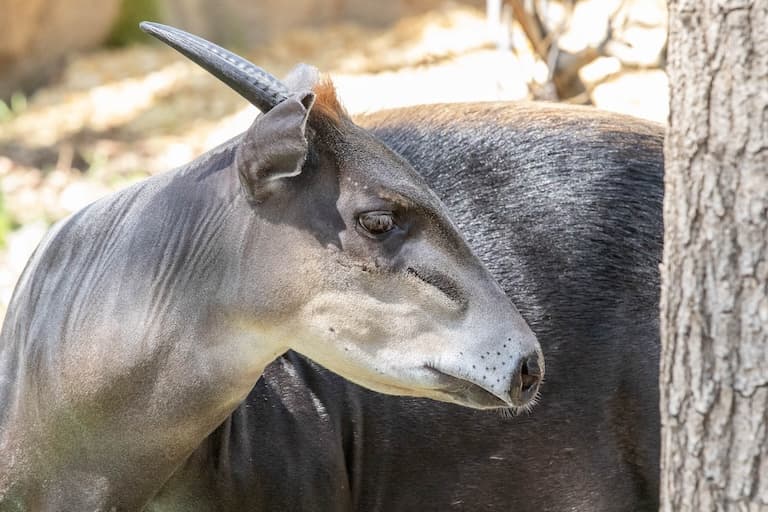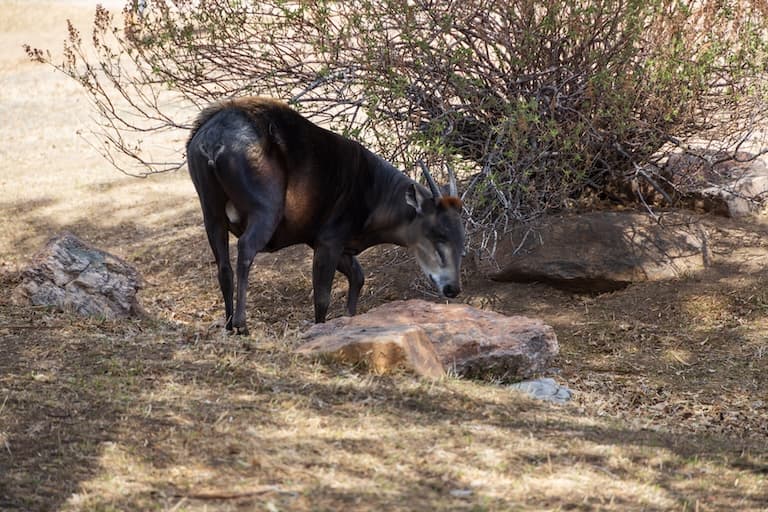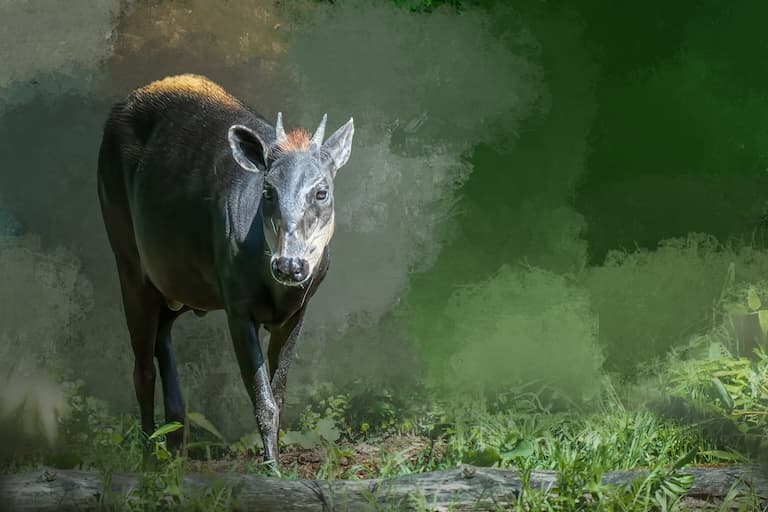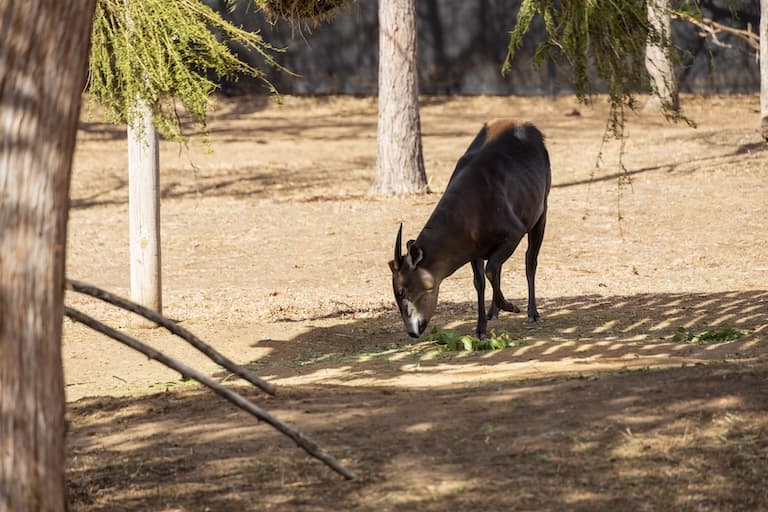Yellow-backed Duiker Profile
Duikers are typically very small animals, and some of the smallest bovids you can find, getting as little as 50cm tall. But the largest of the duikers is no such dwarf!
At up to 80kg in weight, it stands with the medium sized antelope in size, but keeps the very duiker-like escape mechanisms that give the subfamily their name.

Yellow-backed Duiker Facts Overview
| Habitat: | Forests |
| Location: | Central and West Africa |
| Lifespan: | 12 years in the wild, while 22.5 years in captivity |
| Size: | Around 145 cm (57 in) long |
| Weight: | 60–80 kg |
| Colour: | Black or brown |
| Diet: | Fruit, leaves, roots, bark |
| Predators: | Hunting dogs, lions, and leopards, hyenas, humans |
| Top Speed: | Unknown |
| No. of Species: | 1 |
| Conservation Status: | Near Threatened |
The yellow-backed duiker is a handsome and enormous member of the duiker subfamily, and a medium-sized antelope over all. Like all duikers, it has some smelly bits and some pretty bits, and these work together to make it a charismatic – if a little weird – bovid from Central and West Africa.
Its size also makes it a popular target for hunting, and unfortunately, recent developments have shown hunters a way to take advantage of its freeze-response, leading to a population decline that could cause the species trouble in the near future.
Interesting Yellow-backed Duiker Facts
1. They’re big
The yellow-backed duiker is not your typical duiker.
Duikers are a subfamily of antelope, which are basically African deer as much as far as their niches are concerned, but they are actually quite unrelated to deer taxonomically, and are members of the cow and goat family, Bovidae.
In fact, the reason you so rarely find deer and antelope in the same place is precisely because they are doing the exact same thing in their respective ecosystems so there’s no room for the other.
The heaviest antelope are actually even heavier than the heaviest deer (the moose) and the smallest are even smaller, so antelope occupy more extreme ends of the size spectrum, too. Duikers get to be pretty small, too, at about 50cm tall, and typically, this subfamily is just one above the very tiny Dik-diks at this low end, but the yellow-backed duiker is a pretty remarkable exception, being that it reached up to 80 kg, and more than the common bushbucks in weight.
But despite its relatively huge size, the yellow-backed duiker retains its duiker reputation.

2. Holy Divers!
Duikers are so-named because of their ability to avoid predators. The name comes from the Afrikaans for “diver”, and it refers to the duiker’s habit of disappearing into brush when it gets scared.
These typically small antelope can’t do much to physically protect themselves from a large predator, but they can hide, and they can do that very well, and even this species, being as large as it is, hadn’t lost that ability.
As you’d expect, the duikers live mostly in areas where there is stuff to hide in, but this big one ventures out into open bush too, and can be found in forest clearings, perhaps more than its more timid smaller kin.
3. Yellow erections
This is something that would signify a medical emergency in humankind, but in this duiker it’s a feature, not a bug. The yellow back that this species’ common name refers to is a patch of erectile tissue covered in yellow hair on the animal’s back.
These hairs are more than twice as long as the surrounding fur, and this means that while flat they can be relatively concealed when necessary – say, when the animal is hiding in a green bush to avoid detection – and when needed they can be presented at full attention.
Much like a dog’s hackles, this strip of hair stands up as a way of making the duiker look bigger and signify its preparedness to face danger. This is mostly used between duikers of the same species, but could also function against a smaller predator that might be trying to get at the juveniles of an older individual.
A second line of defence comes from the smelly end 1.

5. Leaky glands
Another potentially concerning symptom of human biology that is commonplace in duikers, is a large, seeping opening in its face.
Because for these antelope, the smelly end is actually the front, and duiker glands are fascinating and somewhat unsettling organs that can open and close a bit like an empty eye socket.
When they’re open, they release a thick, smelly liquid. And this is on purpose. It has a multitude of uses, including marking territory and telling other duikers to keep their distance. When they’re closed, they look sort of like a second eye, just slightly in front of and under the real one.
Unfortunately, the real ones have come to be the yellow-backed duiker’s Achilles heel2.
6. Deer in headlights
Being a large antelope, these duikers provide a lot of calories to the local hunters. Unfortunately for the duiker, these hunters have recently figured out that if you shine a light into the duiker’s eyes at night, they freeze in place, and can often be approached without any issue.
While this exploit now feeds local hunters even more than it did before, it’s also contributing to an rise in grinning idiots from abroad, posing like psychopaths behind the duiker’s lifeless body. These two approaches combined, have begun a dangerous decline in the yellow-backed duiker’s population.

7. They’re Near Threatened
African mammals have held out longer than mammals of other continents, for the most part. As humans expanded around the planet they acted much like the invasive pigs and rats on isolated islands, and took advantage of fauna that had never evolved to compensate for team-working, spear-throwing monkeys.
But African mammals very much did evolve in the presence of this threat, which is why there are still so many of them left. Unfortunately, one thing they didn’t evolve for is the sidden jump in technology in the form of guns and torches, and so this endurance does appear to be reaching its crescendo for many. Including this poor Duiker, whose adaptations have not yet included a sensible response to a bright torch light.
Essentially, they are now far too easy to kill, and this has resulted in a rapid decline in their populations, and one that will put them in a worrying position if it’s not curbed.3
Yellow-backed Duiker Fact-File Summary
Scientific Classification
| Kingdom: | Animalia |
| Phylum: | Chordata |
| Class: | Mammalia |
| Order: | Artiodactyla |
| Family: | Bovidae |
| Genus: | Cephalophus |
| Species Name: | Silvicultor |
Fact Sources & References
- “Yellow-Backed Duiker”, IUCN Red List.
- Brent Huffman (2024), “Cephalophus silvicultor”, Discover the Ungulates of the World.
- (2016), “Yellow-backed Duiker”, IUCN Redlist.
